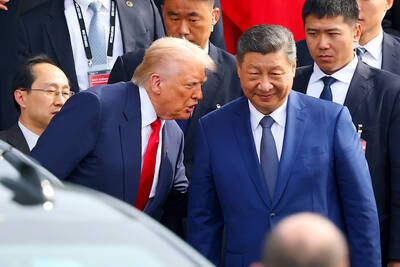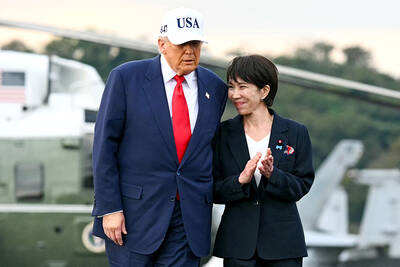The US State Department has notified Congress that it is going ahead with three arms sales programs to Taiwan — after holding them up for more than six months.
While the programs are not huge — they involve radar upgrades for Indigenous Defense Fighters (IDF) — the move could be significant in that it shows US President Barack Obama standing up to China and supporting Taiwan despite Beijing’s protests.
Rupert Hammond-Chambers, president of the US-Taiwan Business Council, said the move signaled an “apparent change in policy.”
According to the council, after the White House released several programs from former US president George W. Bush’s administration for congressional notification in January, a decision was made to submit no further notifications for the year.
Thus the latest congressional notification would seem to indicate that the “hold” on arms sales to Taiwan has been lifted by the Obama administration.
The decision to lift the “hold” seems to have been made at about the same time that it was decided to release a long-delayed Pentagon report on the Chinese military that revealed a continuing and secretive buildup by Beijing with the balance of power across the Taiwan Strait leaning substantially in China’s favor.
The Pentagon report also noted China’s lack of cooperation with the US on military affairs.
China has strongly objected to all US arms sales to Taiwan and in the hope of reducing tensions with Beijing, Washington has exercised extreme caution.
However, as the Washington Post recently said in a front-page story: “The Obama administration has adopted a tougher tone with China.”
The newspaper said the US had rejected China’s claims to sovereignty over the whole South China Sea; rebuffed Chinese demands that the US military end its long-time policy of conducting military exercises in the Yellow Sea; and was putting new pressure on Beijing not to increase its energy investments in Iran as Western firms leave.
US officials told the Post that the moves were part of a broader strategy to acknowledge China’s emergence as a world power, but to also “lay down markers when China’s behavior infringes on US interests.”
The council said the latest military sales were a “small move to end Taiwan arms freezes.”
It said the recent policy under both the Bush and Obama administrations — freezing Taiwan arms sales notifications and then releasing them as packages — has had the “inverse effect of its apparent intent.”
“By creating multi-billion dollar packages that capture headlines, the policy has increased Chinese ire at such sales rather than reducing it,” the council said.
“China has rightly deduced that the process is vulnerable to external pressure, and recently applied such pressure by threatening sanctions against American companies and by denying entry to China for US Secretary of Defense Robert Gates,” the council said.
China, the council says, was employing a carrot-and-stick strategy with Taiwan, offering significant economic incentives with the recently signed Economic Cooperation Framework Agreement (ECFA) while continuing military modernization and expanding the material threat represented by the People’s Liberation Army (PLA).
"This strategy compels a response from both Taiwan and the United States,” the council said. “Allowing China’s military threat to go unmet threatens any hope of long-term success in reducing cross-strait tensions.”
“Both the US and Taiwan must determine which actions to take in support of Taiwan’s national security, without caving to pressure from China. Regularizing the Taiwan arms sales process will in the long term make support for Taiwan’s defense needs more transparent and stable,” it said.
“The US Department of Defense is due to submit to Congress a second report by the end of 2010 examining the current balance of airpower in the Taiwan Strait and making recommendations for US action,” Hammond-Chambers said. “This will include consideration of the impact of replacement fighters for Taiwan’s aging air force. F-16s are the only platform under consideration for Taiwan, but the F-16 manufacturing line will begin to wind down in July of 2011. This leaves a narrow 10-month window for a decision on making the requested 66 F-16s available to Taiwan.”
“Taiwan is also looking to upgrade its current fleet of 145 F-16s, and in the absence of political obstruction a congressional notification is due for this program some time in the winter of 2010-2011,” he said.
The Chinese believe Taiwan should be denied access to replacement fighters for their aging F-5s and Mirage-2000s, recognizing the serious detrimental effect such a denial would have on Taiwan’s military readiness, he said.
A senior White House source refused to comment on the issue.

CALL FOR SUPPORT: President William Lai called on lawmakers across party lines to ensure the livelihood of Taiwanese and that national security is protected President William Lai (賴清德) yesterday called for bipartisan support for Taiwan’s investment in self-defense capabilities at the christening and launch of two coast guard vessels at CSBC Corp, Taiwan’s (台灣國際造船) shipyard in Kaohsiung. The Taipei (台北) is the fourth and final ship of the Chiayi-class offshore patrol vessels, and the Siraya (西拉雅) is the Coast Guard Administration’s (CGA) first-ever ocean patrol vessel, the government said. The Taipei is the fourth and final ship of the Chiayi-class offshore patrol vessels with a displacement of about 4,000 tonnes, Lai said. This ship class was ordered as a result of former president Tsai Ing-wen’s (蔡英文) 2018

UKRAINE, NVIDIA: The US leader said the subject of Russia’s war had come up ‘very strongly,’ while Jenson Huang was hoping that the conversation was good Chinese President Xi Jinping (習近平) and US President Donald Trump had differing takes following their meeting in Busan, South Korea, yesterday. Xi said that the two sides should complete follow-up work as soon as possible to deliver tangible results that would provide “peace of mind” to China, the US and the rest of the world, while Trump hailed the “great success” of the talks. The two discussed trade, including a deal to reduce tariffs slapped on China for its role in the fentanyl trade, as well as cooperation in ending the war in Ukraine, among other issues, but they did not mention

Japanese Prime Minister Sanae Takaichi yesterday lavished US President Donald Trump with praise and vows of a “golden age” of ties on his visit to Tokyo, before inking a deal with Washington aimed at securing critical minerals. Takaichi — Japan’s first female prime minister — pulled out all the stops for Trump in her opening test on the international stage and even announced that she would nominate him for a Nobel Peace Prize, the White House said. Trump has become increasingly focused on the Nobel since his return to power in January and claims to have ended several conflicts around the world,

GLOBAL PROJECT: Underseas cables ‘are the nervous system of democratic connectivity,’ which is under stress, Member of the European Parliament Rihards Kols said The government yesterday launched an initiative to promote global cooperation on improved security of undersea cables, following reported disruptions of such cables near Taiwan and around the world. The Management Initiative on International Undersea Cables aims to “bring together stakeholders, align standards, promote best practices and turn shared concerns into beneficial cooperation,” Minister of Foreign Affairs Lin Chia-lung (林佳龍) said at a seminar in Taipei. The project would be known as “RISK,” an acronym for risk mitigation, information sharing, systemic reform and knowledge building, he said at the seminar, titled “Taiwan-Europe Subsea Cable Security Cooperation Forum.” Taiwan sits at a vital junction on